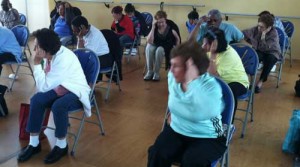By José de la Isla
Hispanic Link News Service, New Orleans
In Death with Interruption, the late Portuguese novelist and Nobel laureate José Saramago imagined Death as a white lady who suddenly takes time off. People, in that unnamed country he writes about, stop dying. The funeral industry collapses. Hospitals routines are disrupted. When critically ill patients want to die some of them are taken across national borders to the neighboring country to pass away. The government colludes with a mafia about these problems.
But that’s a novel, after all. It couldn’t really happen. Death never takes a holiday, right? Well, don’t bet on it.
A similar but generally less chaotic scenario was presented at the Gerontological Society of America scientific meetings here in late November. It posed the scientific possibility, aiming to become a probability if public and private support comes through, to extend life as a way to prevent chronic disease.
Already, 50 scientists met in October at a summit at the National Institutes of Health (NIH) to present research on the drivers of aging and chronic disease.
This is the key part of a radical new paradigm shift. Previously, health has been thought about as a struggle against diseases that bring about death later in life as people age. Now that way of thinking has changed to look at aging itself as what is driving chronic diseases that bring death. If what drives aging could be found, the discovery could help the prevention of disease.
Boston University’s Robert B. Hudson, editor of Public Policy & Aging Report, puts across this perspective in the latest issue of that journal. He claims attacking aging (as a reversible condition) is a viable and efficient approach “to reducing the risk of all fatal and disabling diseases and improving well-being.”
S. Jay Olshansky, of the University of Illinois, Chicago’s School of Public Health, writes in that report, “The final and most important goal of extending the period of healthy life” shakes up the belief “that aging is a product of time passing.” “Science,” he says, “has now demonstrated that aging is inherently modifiable.”
This new “geroscience,” according to Felipe Sierra, director of the National Institute on Aging’s biology division, has found the underpinnings of aging. Scientists now know life spans are influenced by genetics, and how long one lives may be altered pharmacologically. Another tentative scientific “observation” is that increased life expectancy appears to coincide with improved health.
These developments should be of particular interest to the Latino public for a special reason.
Analyzing research about average life expectancy and causes of death, Hispanic Link correspondent Jim Lamare reported on the “Hispanic paradox.” For one thing, Latinos generally live longer than the rest of the United States population and have a slightly lower prevalence of heart and cancer as causes of death than non-Hispanic Whites and African Americans.
Generally, the amount of education a person has can help determine a longer life for the population. That’s also the case for Hispanic men.
Yet, in the case of California, where some of the more extensive studies have been done concerning socioeconomic status and aging, living in a low, middle or high-income neighborhood is also associated with how long a person lives. But the generalization is less true for Latinos, where socioeconomic status seems not to make such a big difference.
Maybe the determining factors are genes and healthy living for those people who live longer, especially recent immigrants. If that is a naturally occurring situation for a segment of the Latino population, researchers could hope to study Latino life expectancy further in order that the general population can attain a similar level.
If so, the Hispanic longevity paradox may be a benchmark for U.S. society in general. Could it be that in terms of defying death, the rest of society should reach toward a Latino standard?
At the end of Saramago’s novel, the white lady falls in love with a terminally ill cellist. “Will death succumb to human love?” Publishers Weekly asks in its review.
Similarly, geroscience researchers could ask, as a novelist would, if death’s fury can be tamed by a cellist playing a Latin tune.
[José de la Isla, a nationally syndicated columnist for Hispanic Link and Scripps Howard news services, wrote this article through a MetLife Journalists in Aging Fellowship, a program of New America Media (NAM) and the Gerontological Society of America. His forthcoming book is “Ashes in the River.” Other books by him include “DAY NIGHT LIFE DEATH HOPE” (2009) and “The Rise of Hispanic Political Power” (2004)].
See this column in Spanish and more news and commentary at www.HispanicLink.org.














